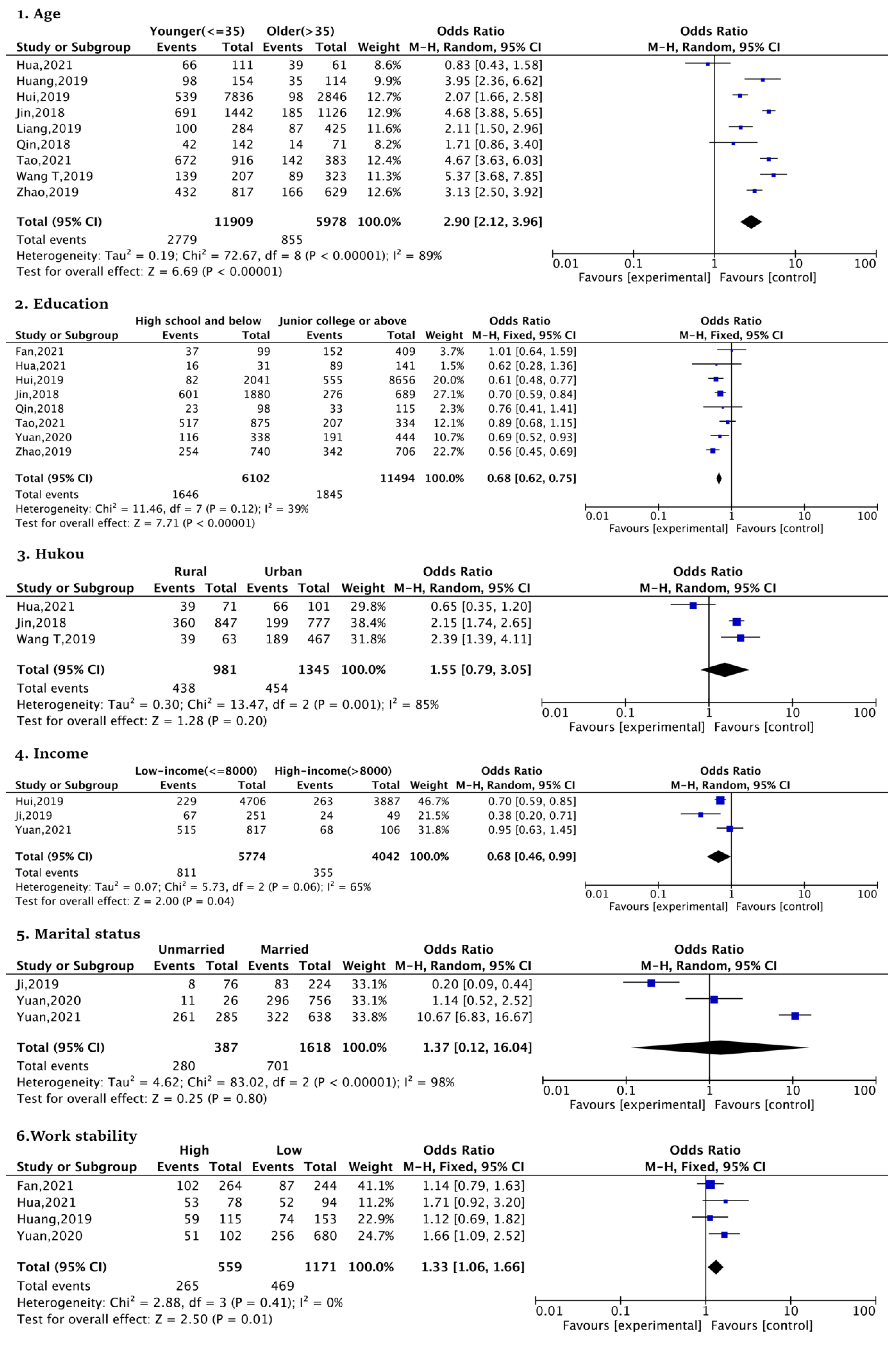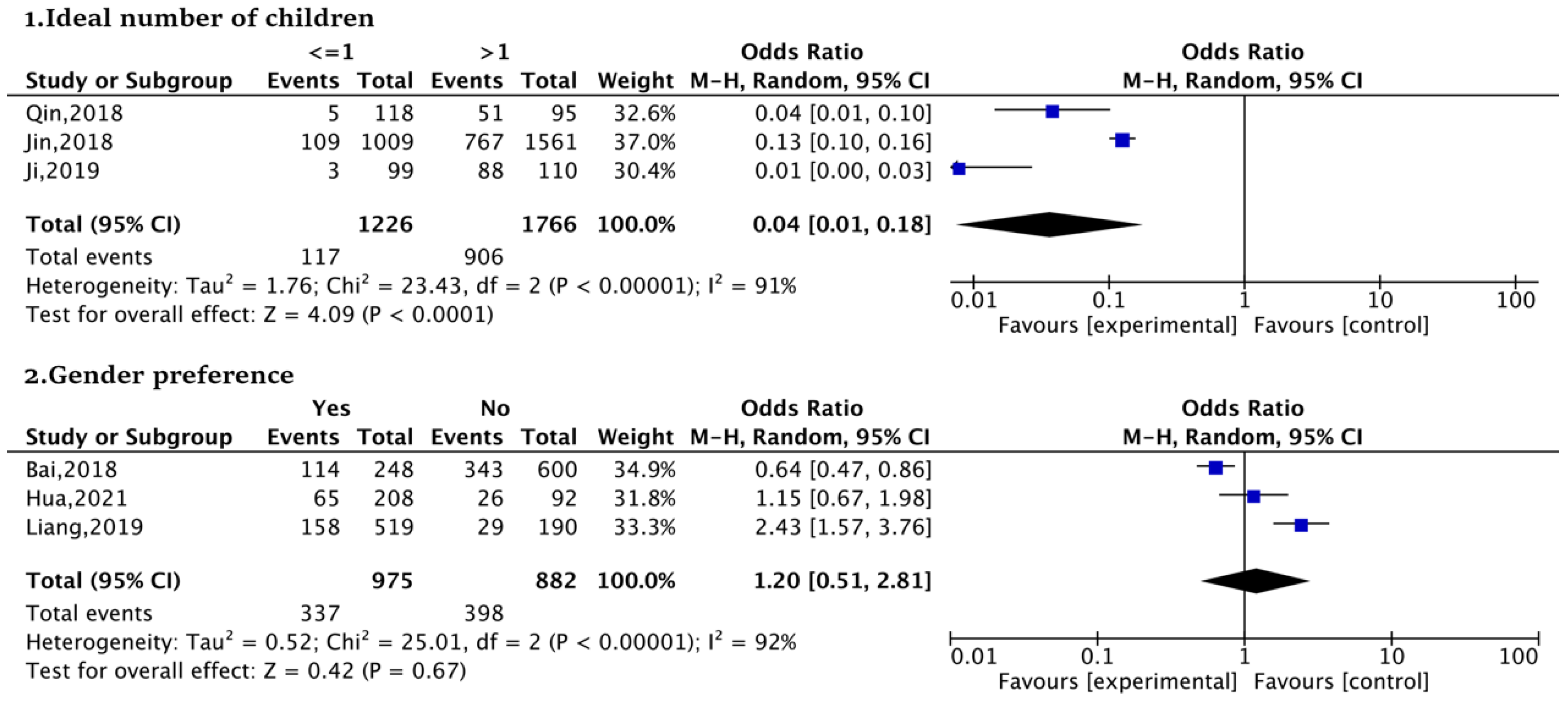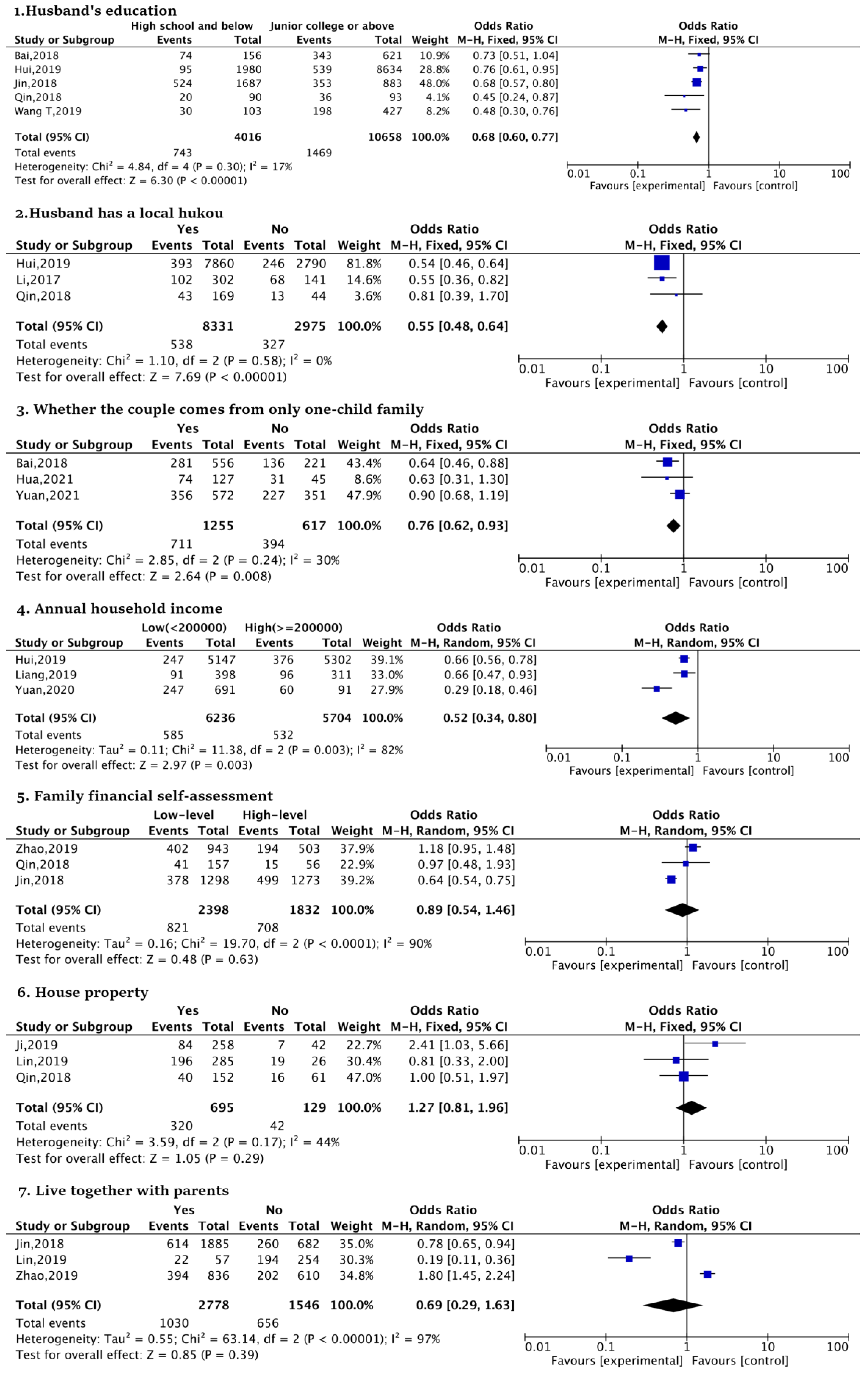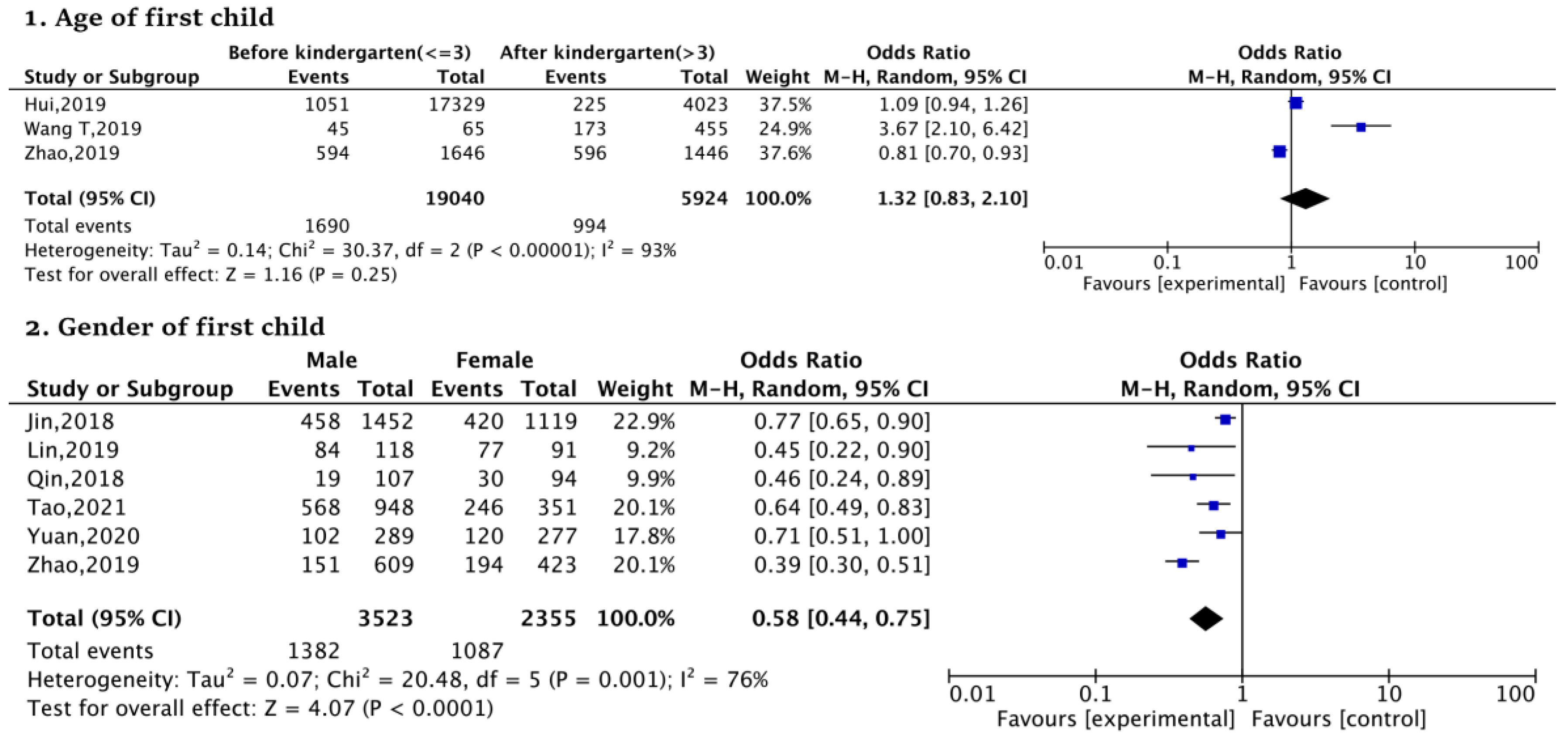Second-Child Fertility Intentions among Urban Women in China: A Systematic Review and Meta-Analysis
Abstract
1. Introduction
2. Materials and Methods
2.1. Data Sources and Searches
2.2. Study Selection
2.3. Data Extraction and Quality Assessment
2.4. Data Synthesis and Statistical Analysis
3. Results
3.1. Literature Search
3.2. Study Characteristics
3.3. Principal Findings
3.4. Meta-Analysis
3.4.1. Factors Related to SFI among Urban Women
3.4.2. Individual Level Factors and SFI
3.4.3. Family Level Factors and SFI
4. Discussion
5. Conclusions
6. Limitations, Strengths and Literature Gaps
Supplementary Materials
Author Contributions
Funding
Institutional Review Board Statement
Informed Consent Statement
Data Availability Statement
Conflicts of Interest
References
- United Nations Department of Economic and Social Affairs Population Division. World Population Prospects 2022 Summary of Results; United Nations: New York, NY, USA, 2022. [Google Scholar]
- United Nations Population Fund. State of World Population 2019; UNFPA: New York, NY, USA, 2019. [Google Scholar]
- Mu, G.; Lin, J. The fertility-friendly society—Risk and governance in the era of endogenous low fertility. Explor. Free Views 2021, 1, 178. [Google Scholar]
- Jiang, Q.; Li, Y.; Sanchez-Barricarte, J.J. Fertility Intention, Son Preference, and Second Childbirth: Survey Findings from Shaanxi Province of China. Soc. Indic. Res. 2016, 125, 935–953. [Google Scholar] [CrossRef] [PubMed]
- Zhou, M.; Guo, W. Fertility intentions of having a second child among the floating population in China: Effects of socioeconomic factors and home ownership. Popul. Space Place 2020, 26, 2289. [Google Scholar] [CrossRef]
- National Bureau of Statistics of China, The Head of the 7th National Census Leading Group Office of The State Council Gave an Interview to China News Service. 2021. Available online: http://www.stats.gov.cn/tjsj./zxfb/202105/t20210513_1817432.html (accessed on 3 August 2022).
- Ajzen, I. The theory of planned behaviour: Reactions and reflections. Psychol. Health 2011, 26, 1113–1127. [Google Scholar] [CrossRef]
- Schoen, R.; Astone, N.M.; Kim, Y.J.; Nathanson, C.A.; Fields, J.M. Do fertility intentions affect fertility behavior? J. Marriage Fam. 1999, 61, 790–799. [Google Scholar] [CrossRef]
- Modena, F.; Rondinelli, C.; Sabatini, F. Economic insecurity and fertility intentions: The case of Italy. Rev. Income Wealth 2014, 60, S233–S255. [Google Scholar] [CrossRef]
- Zhu, W.; Hong, X. Are Chinese Parents Willing to Have a Second Child? Investigation on the Ideal and Realistic Fertility Willingness of Different Income Family. Early Educ. Dev. 2022, 33, 375–390. [Google Scholar] [CrossRef]
- Fiori, F.; Graham, E.; Rinesi, F. Economic reasons for not wanting a second child: Changes before and after the onset of the economic recession in Italy. Demogr. Res. 2018, 38, 843–854. [Google Scholar] [CrossRef]
- Choi, S.-W.; Horse, A.J.Y.; Yang, T.-C. Family policies and working women’s fertility intentions in South Korea. Asian Popul. Stud. 2018, 14, 251–270. [Google Scholar] [CrossRef]
- Kim, E.J.; Parish, S.L. Family-supportive workplace policies and benefits and fertility intentions in South Korea. Community Work. Fam. 2022, 25, 464–491. [Google Scholar] [CrossRef]
- Bueno, X.; Brinton, M.C. Gender egalitarianism, perceived economic insecurity, and fertility intentions in Spain: A qualitative analysis. Popul. Stud.-A J. Demogr. 2019, 73, 247–260. [Google Scholar] [CrossRef]
- Li, Y.R. The Effect of Air Pollution on Fertility Intentions. Probl. Ekorozw. 2021, 16, 165–170. [Google Scholar] [CrossRef]
- Chen, S.-M.; Zhang, Y.; Wang, Y.-B. Individual differences in relative fertility costs and fertility benefits and their effects on fertility desire for a second child in China: A latent profile analysis. Reprod. Health 2019, 16, 110. [Google Scholar] [CrossRef] [PubMed]
- Kato, T. Associations of gender role attitudes with fertility intentions: A Japanese population-based study on single men and women of reproductive ages. Sex. Reprod. Healthc. 2018, 16, 15–22. [Google Scholar] [CrossRef] [PubMed]
- Liu, P.; Cao, J.; Nie, W.; Wang, X.; Tian, Y.; Ma, C. The Influence of Internet Usage Frequency on Women’s Fertility Intentions-The Mediating Effects of Gender Role Attitudes. Int. J. Environ. Res. Public Health 2021, 18, 4784. [Google Scholar] [CrossRef]
- Morales, D.X. Partners’ Educational Pairings and Fertility Intentions in the United States: Evidence from 2015–2017 National Survey of Family Growth. Soc. Curr. 2020, 7, 299–309. [Google Scholar] [CrossRef]
- Wang, T.; Wang, C.; Zhou, Y.; Zhou, W.; Luo, Y. Fertility intentions for a second child among urban working women with one child in Hunan Province, China: A cross-sectional study. Public Health 2019, 173, 21–28. [Google Scholar] [CrossRef]
- Zhang, J.; Li, X.; Tang, J. Effect of public expenditure on fertility intention to have a second child or more: Evidence from China’s CGSS survey data. Cities 2022, 128, 103812. [Google Scholar] [CrossRef]
- Zheng, Y.M.; Yuan, J.Q.; Xu, T.; Chen, M.; Liang, H.; Donovan, C.; Gao, Y.Q.; Sun, W.J.; Shankar, N.; Lu, C.W.; et al. Socioeconomic status and fertility intentions among Chinese women with one child. Hum. Fertil. 2016, 19, 43–47. [Google Scholar] [CrossRef]
- Yu, J.; Xie, Y. The effect of fertility on women’s wages in China. Popul. Res. 2014, 38, 18–29. [Google Scholar]
- Lai, D. China Labor Market Development Report 2016—Women’s Employment on Gender Equality Progress; Beijing Normal University Press: Bejing, China, 2017; pp. 147–160. [Google Scholar]
- Ji, Y.; Zheng, Z.; Li, G. China’s Low Fertility Rate from Perspective of Gender and Development. Soc. Sci. China 2020, 41, 169–184. [Google Scholar]
- Mills, M.; Mencarini, L.; Tanturri, M.L.; Begall, K. Gender equity and fertility intentions in Italy and the Netherlands. Demogr. Res. 2008, 18, 1. [Google Scholar] [CrossRef]
- Balbo, N.; Billari, F.C.; Mills, M. Fertility in Advanced Societies: A Review of Research. Eur. J. Popul.-Rev. Eur. Demogr. 2013, 29, 1–38. [Google Scholar] [CrossRef]
- Pink, S.; Leopold, T.; Engelhardt, H. Fertility and social interaction at the workplace: Does childbearing spread among colleagues? Adv. Life Course Res. 2014, 21, 113–122. [Google Scholar] [CrossRef]
- Zhang, C.C.; Li, T. Culture, fertility and the socioeconomic status of women. China Econ. Rev. 2017, 45, 279–288. [Google Scholar] [CrossRef]
- Kan, M.-Y.; Hertog, E.; Kolpashnikova, K. Housework share and fertility preference in four East Asian countries in 2006 and 2012. Demogr. Res. 2019, 41, 1021–1046. [Google Scholar] [CrossRef]
- Glauber, R. Trends in the Motherhood Wage Penalty and Fatherhood Wage Premium for Low, Middle, and High Earners. Demography 2018, 55, 1663–1680. [Google Scholar] [CrossRef]
- Avellar, S.; Smock, P.J. Has the price of motherhood declined over time? A cross-cohort comparison of the motherhood wage penalty. J. Marriage Fam. 2003, 65, 597–607. [Google Scholar] [CrossRef]
- Jiang, Y.; Yang, F. Motherhood Health Penalty: Impact of Fertility on Physical and Mental Health of Chinese Women of Childbearing Age. Front. Public Health 2022, 10, 787844. [Google Scholar] [CrossRef]
- Arun, S.V.; Arun, T.G.; Borooah, V.K. The effect of career breaks on the working lives of women. Fem. Econ. 2004, 10, 65–84. [Google Scholar] [CrossRef]
- Doepke, M.; Kindermann, F. Bargaining over Babies: Theory, Evidence, and Policy Implications. Am. Econ. Rev. 2019, 109, 3264–3306. [Google Scholar] [CrossRef]
- Heiland, F.; Prskawetz, A.; Sanderson, W.C. Are individuals’ desired family sizes stable? Evidence from West German panel data. Eur. J. Popul.-Rev. Eur. Demogr. 2008, 24, 129–156. [Google Scholar] [CrossRef]
- Testa, M.R. On the positive correlation between education and fertility intentions in Europe: Individual- and country-level evidence. Adv. Life Course Res. 2014, 21, 28–42. [Google Scholar] [CrossRef] [PubMed]
- He, X.; Lin, L. Household income per capita, female education level and Chinese women of childbearing age’s intention to give birth to a second child: An empirical analysis based on CGSS2017 data. Fujian Trib. 2021, 18, 98–108. [Google Scholar]
- Gatta, A.; Mattioli, F.; Mencarini, L.; Vignoli, D. Employment uncertainty and fertility intentions: Stability or resilience? Popul. Stud.-A J. Demogr. 2022, 76, 387–406. [Google Scholar] [CrossRef]
- Moher, D.; Liberati, A.; Tetzlaff, J.; Altman, D.G. Preferred Reporting Items for Systematic Reviews and Meta-Analyses: The PRISMA Statement. Figshare 2009, 151, 264–269. [Google Scholar]
- Modesti, P.A.; Reboldi, G.; Cappuccio, F.P.; Agyemang, C.; Remuzzi, G.; Rapi, S.; Perruolo, E.; Parati, G.; Low, E.S.H.W.G.C.R. Panethnic Differences in Blood Pressure in Europe: A Systematic Review and Meta-Analysis. PLoS ONE 2016, 11, 0147601. [Google Scholar] [CrossRef]
- Higgins, J.P.T.; Thompson, S.G.; Deeks, J.J.; Altman, D.G. Measuring inconsistency in meta-analyses. Br. Med. J. 2003, 327, 557–560. [Google Scholar] [CrossRef]
- Yuan, C.; Wang, x.; Chen, F.; Li, Y.; Tang, Z. Study on the willingness of women of childbearing age to have a second child and its influencing factors under the universal two-child policy in Xi’an. J. Shen Zhou 2021, 1, 209–210. [Google Scholar] [CrossRef]
- Hua, H. Research on the Career Women’s Fertility Desire and Its Influence Factors under the Background of Universal Two-Child Policy. Master’s Thesis, Jilin University of Finance and Economic, Changchun, China, 2021. [Google Scholar]
- Fan, H.; Zhang, H.; Zhang, N. Family support or personal Choice—A study on the influencing factors of urban working women’s willingness to have a second child. Manag. Eng. 2021, 26, 60–69. [Google Scholar] [CrossRef]
- Yuan, S.; Hu, B.; Luo, G. Investigation and analysis on fertility intention and influencing factors of women of childbearing age in Ningbo city under the background of the universal two-child policy. Matern. Child Health Care China 2020, 35, 314–318. [Google Scholar] [CrossRef]
- Ji, Q. The research on fertility willingness of child-bearing age women under the two-child policy—Taking Huangdao district of Qingdao city as an example. Master’s Thesis, Shandong University of Science and Technology, Qingdao, China, 2019. [Google Scholar]
- Huang, X.; Xu, H.; Lu, P. Study on mental resilience of working women and their willingness to bear children under “Second Child”policy in Changchun City. Occup. Health 2019, 35, 2381–2385. [Google Scholar] [CrossRef]
- Zhao, Y.; Dai, L.; Duan, X. Childbearing Age Women’s Fertility Willingness of Second Child in Beijing and Its Influencing Factors. Med. Soc. 2019, 32, 75–79. [Google Scholar] [CrossRef]
- Lin, Y.; He, L.; Chen, C.; Li, Q. Study on the willingness to have a second child and influencing factors among women of childbearing age in Putian City. J. Jiujiang Univ. 2019, 34, 90–94. [Google Scholar] [CrossRef]
- Hui, J. Analysis of women’s desire to reproduce and its influencing factors in Shanghai. Master’s Thesis, Shanghai Academy of Social Sciences, Shanghai, China, 2019. [Google Scholar]
- Li, S.; Tao, J.; He, L.; He, Y.; Chen, Y.; Zhang, Q. Research on the second-child bearing willingness of fertile women in Chengdu City and the influencing factors under the universal two-child policy. Mod. Prev. Med. 2017, 44, 3706–3709. [Google Scholar]
- Liang, A. Birth Desire and Influencing Factors in Those Women with One Child under the Comprehensive Two-Child Policy. J. Int. Reprod. Health/Fam. Plan. 2019, 38, 5–10. [Google Scholar]
- Qin, X.; Sun, R.; He, J.; Sha, M.; Liu, Y. Research on the two⁃childbirth expectation for the married and child⁃bearing age women in the urban area of Nanchong City. J. Nanjing Med. Univ. 2018, 18, 353–358. [Google Scholar]
- Jin, Y.; Zhao, M.; Song, J. Parental Influence on Women’s Second-birth Plan in Urban China. Popul. Res. 2018, 42, 17–29. [Google Scholar]
- Tao, G.; Du, W.; Liang, A.; Chen, M.; Jiang, N.; Wang, T.; Zhang, G. Investigation on the childbearing willingness of women of childbearing age in Guilin city under the policy of “comprehensive two-child”. J. Shenyang Med. Coll. 2021, 23, 39–46. [Google Scholar] [CrossRef]
- Ge, B.; Shengnan, W.; Al, E. Investigation on Fertility Intention of Shanghai Residents Under The Universal Two—Child Policy. Med. Soc. 2018, 31, 53–55. [Google Scholar] [CrossRef]
- Sobotka, T. Sub-Replacement Fertility Intentions in Austria. Eur. J. Popul.-Rev. Eur. Demogr. 2009, 25, 387–412. [Google Scholar] [CrossRef]
- Bein, C.; Mynarska, M.; Gauthier, A.H. Do costs and benefits of children matter for religious people? Perceived consequences of parenthood and fertility intentions in Poland. J. Biosoc. Sci. 2021, 53, 419–435. [Google Scholar] [CrossRef] [PubMed]
- Edmonston, B.; Lee, S.M.; Wu, Z. Fertility Intentions in Canada: Change or No Change? Can. Stud. Popul. 2010, 37, 297–337. [Google Scholar] [CrossRef]
- National Bureau of Statistics of China. China Statistical Yearbook; China Statistics Press: Beijing, China, 2022; p. 32.
- Shi, R.; Chen, N.; Zheng, Q. Evaluation on the effect of childbearing policy adjustments in China. Chin. J. Popul. Sci. 2018, 1, 114–128. [Google Scholar]
- Meng, T.; Lyu, S. The impact of the selective two-child policy on residents’ fertility intentions in China. Appl. Econ. Lett. 2022, 29, 1455–1459. [Google Scholar] [CrossRef]
- Clark, W.A.V.; Yi, D.; Zhang, X. Do House Prices Affect Fertility Behavior in China? An Empirical Examination. Int. Reg. Sci. Rev. 2020, 43, 423–449. [Google Scholar] [CrossRef]
- Gray, E.; Evans, A. Geographic variation in parity progression in Australia. Popul. Space Place 2018, 24, 2080. [Google Scholar] [CrossRef]
- Park, S.M.; Cho, S.I.; Jang, S.N.; Cho, Y.T.; Chung, H.W. The preference for an additional child among married women in Seoul, Korea. J. Biosoc. Sci. 2008, 40, 269–281. [Google Scholar] [CrossRef]
- ter Keurst, A.; Boivin, J.; Gameiro, S. Women’s intentions to use fertility preservation to prevent age-related fertility decline. Reprod. Biomed. Online 2016, 32, 121–131. [Google Scholar] [CrossRef]
- Axinn, W.G.; Barber, J.S. Mass education and fertility transition. Am. Sociol. Rev. 2001, 66, 481–505. [Google Scholar] [CrossRef]
- Hanappi, D.; Buber-Ennser, I. When Paid Work Matters for Fertility Intentions and Subsequent Behavior: Evidence from Two Waves of the Austrian Gender and Generation Survey. Comp. Popul. Stud. 2017, 42, 245–279. [Google Scholar] [CrossRef]
- Wang, Q.; Sun, X. Fertility choices in China under the two-child policy. Int. Sociol. 2020, 35, 284–311. [Google Scholar] [CrossRef]
- Goldstein, J.; Lutz, W.; Testa, M.R. The emergence of sub-replacement family size ideals in Europe. Popul. Res. Policy Rev. 2003, 22, 479–496. [Google Scholar] [CrossRef]
- Testa, M.R.; Bordone, V.; Osiewalska, B.; Skirbekk, V. Are daughters’ childbearing intentions related to their mothers’ socio-economic status? Demogr. Res. 2016, 35, 581–616. [Google Scholar] [CrossRef]
- Zhou, M.; Guo, W. Comparison of second-child fertility intentions between local and migrant women in urban China: A Blinder-Oaxaca decomposition. J. Ethn. Migr. Stud. 2021, 47, 2417–2438. [Google Scholar] [CrossRef]
- Chen, F.; Liu, G.; Mair, C.A. Intergenerational Ties in Context: Grandparents Caring for Grandchildren in China. Soc. Forces 2011, 90, 571–594. [Google Scholar] [CrossRef] [PubMed]
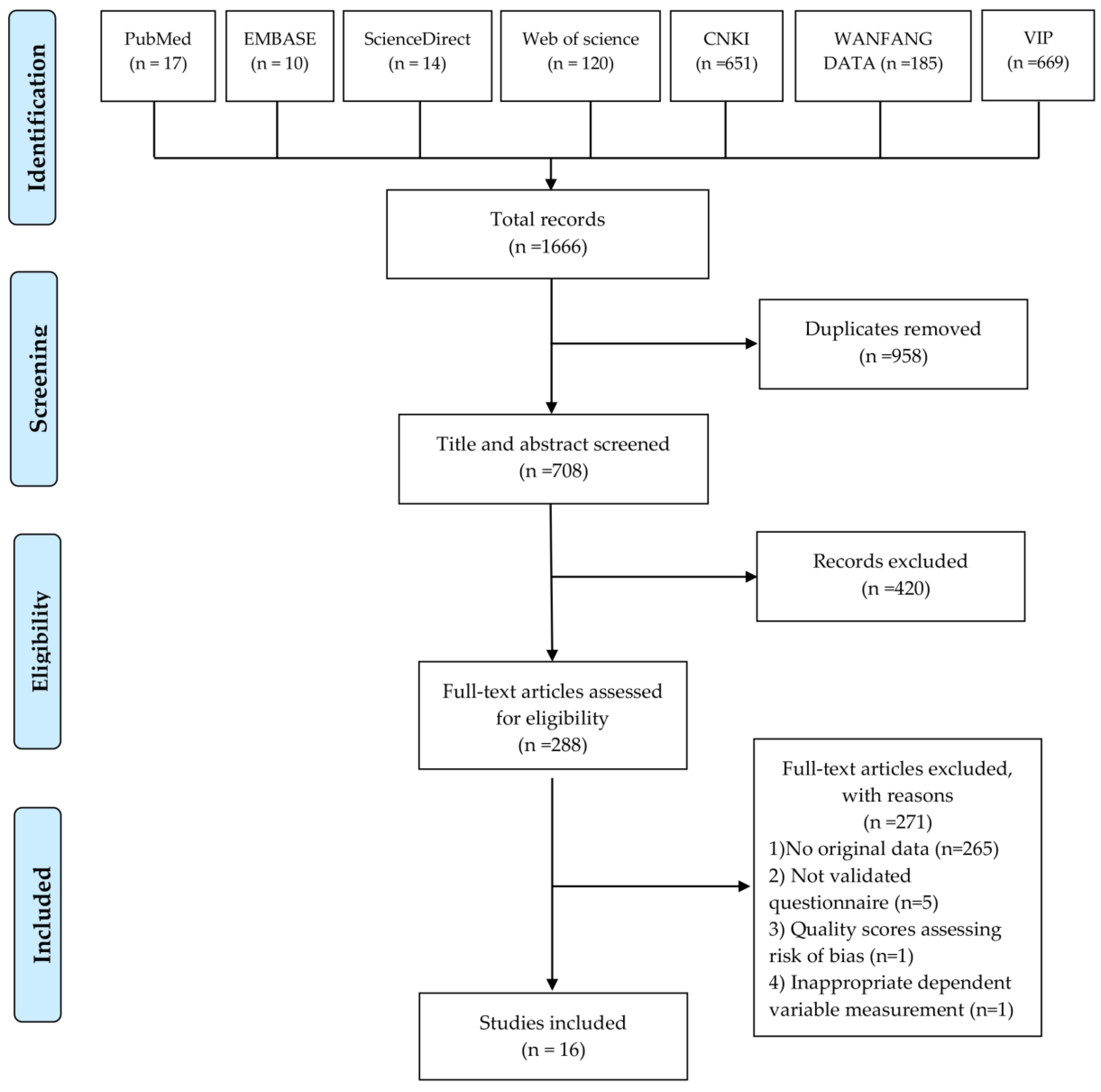
| Authors | Location | Number (Qualified Rate %) | Prevalence of FI, N Persons (%) | Ref. No. |
|---|---|---|---|---|
| Yuan, 2021 [43] | Xi’an | 1152 (96.00%) | 583 (50.6%) | 213 |
| Hua, 2021 [44] | Nanjing | 305 (95.80%) | 133 (43.61%) | 186 |
| Fan, 2021 [45] | Zhengzhou | 508 (84.70%) | 189 (37.2%) | 177 |
| Yuan, 2020 [46] | Ningbo | 972 (97.20%) | 307 (31.60%) | 144 |
| Ji, 2019 [47] | Qingdao | 300 (93.75%) | 91 (30.30%) | 137 |
| Huang, 2019 [48] | Changchun | 268 (94.04%) | 133 (49.63%) | 134 |
| Zhao, 2019 [49] | Beijing | 1446 (95.40%) | 598 (41.22%) | 132 |
| Lin, 2019 [50] | Putian | 311 (94.24%) | 215 (69.13%) | 128 |
| Hui, 2019 [51] | Shanghai | 12,722 (99.76%) | 641 (5.00%) | 121 |
| Li, 2017 [52] | Chengdu | 523 (96.00%) | 170 (32.50%) | 109 |
| Liang, 2019 [53] | Shanghai | 904 (98.30%) | 187 (20.70%) | 95 |
| Qin, 2018 [54] | Nanchong | 213 (100.00%) | 56 (26.30%) | 87 |
| Jin, 2018 [55] | 12 cities of 6 provinces * | 2799 (100.00%) | 876 (31.3%) | 83 |
| Tao, 2021 [56] | Guilin | 1708 (94.89%) | 814 (47.66%) | 62 |
| Bai, 2018 [57] | Shanghai | 848 (80.76%) | 417 (49.17%) | 21 |
| Wang T, 2019 [20] | Hunan province | 703 (82.40%) | 228 (32.43%) | 4 |
| Variables | Characteristic | Include Studies | Prevalence (95%CI) | Q Test (I2) (%) |
|---|---|---|---|---|
| Overall | 16 | 0.374 (0.259 to 0.488) | 99.7 | |
| By research time | 2016–2017 | 8 | 0.406 (0.322 to 0.490) | 98.3 |
| 2018–2020 | 8 | 0.340 (0.159 to 0.522) | 99.8 | |
| By research site | First-tier cities * | 4 | 0.290 (0.065 to 0.515) | 99.8 |
| New first-tier cities ** | 5 | 0.389 (0.306 to 0.473) | 95.0 | |
| Others | 6 | 0.427 (0.321 to 0.534) | 97.9 |
Disclaimer/Publisher’s Note: The statements, opinions and data contained in all publications are solely those of the individual author(s) and contributor(s) and not of MDPI and/or the editor(s). MDPI and/or the editor(s) disclaim responsibility for any injury to people or property resulting from any ideas, methods, instructions or products referred to in the content. |
© 2023 by the authors. Licensee MDPI, Basel, Switzerland. This article is an open access article distributed under the terms and conditions of the Creative Commons Attribution (CC BY) license (https://creativecommons.org/licenses/by/4.0/).
Share and Cite
Yang, Y.; He, R.; Zhang, N.; Li, L. Second-Child Fertility Intentions among Urban Women in China: A Systematic Review and Meta-Analysis. Int. J. Environ. Res. Public Health 2023, 20, 3744. https://doi.org/10.3390/ijerph20043744
Yang Y, He R, Zhang N, Li L. Second-Child Fertility Intentions among Urban Women in China: A Systematic Review and Meta-Analysis. International Journal of Environmental Research and Public Health. 2023; 20(4):3744. https://doi.org/10.3390/ijerph20043744
Chicago/Turabian StyleYang, Yu, Rongxin He, Ning Zhang, and Liming Li. 2023. "Second-Child Fertility Intentions among Urban Women in China: A Systematic Review and Meta-Analysis" International Journal of Environmental Research and Public Health 20, no. 4: 3744. https://doi.org/10.3390/ijerph20043744
APA StyleYang, Y., He, R., Zhang, N., & Li, L. (2023). Second-Child Fertility Intentions among Urban Women in China: A Systematic Review and Meta-Analysis. International Journal of Environmental Research and Public Health, 20(4), 3744. https://doi.org/10.3390/ijerph20043744





